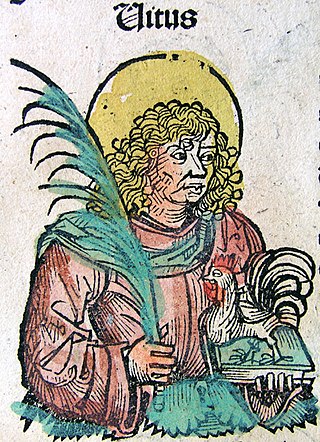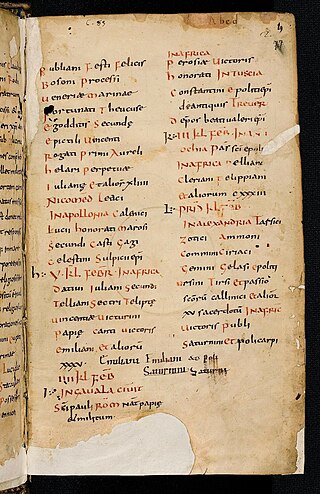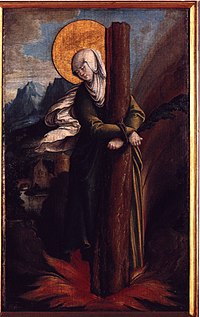
Pope Marcellinus was the bishop of Rome from 30 June 296 to his death in 304. A historical accusation was levelled at him by some sources to the effect that he might have renounced Christianity during Emperor Diocletian's persecution of Christians before repenting afterwards, which would explain why he is omitted from lists of martyrs. The accusation is rejected, among others, by Augustine of Hippo. He is today venerated as a saint in the Catholic Church and in the Serbian Orthodox Church.

Vitus, whose name is sometimes rendered Guy or Guido, was a Christian martyr from Sicily. His surviving hagiography is pure legend. The dates of his actual life are unknown. He has for long been tied to the Sicilian martyrs Modestus and Crescentia but in the earliest sources it is clear that these were originally different traditions that later became combined. The figures of Modestus and Crescentia are probably fictitious.

Erasmus of Formia, also known as Saint Elmo, was a Christian saint and martyr. He is venerated as the patron saint of sailors and abdominal pain. Erasmus or Elmo is also one of the Fourteen Holy Helpers, saintly figures of Christian religion who are venerated especially as intercessors.

August 4 - Eastern Orthodox liturgical calendar - August 6

Saint Anastasia is a Christian saint and martyr who died at Sirmium in the Roman province of Pannonia Secunda. In the Eastern Orthodox Church, she is venerated as St. Anastasia the Pharmakolytria, i.e. "Deliverer from Potions". This epithet is also translated as "One who Cures (Wounds)" in Lampe's A Patristic Greek Lexicon.

August 11 - Eastern Orthodox liturgical calendar - August 13

Juliana of Nicomedia is an Anatolian Christian saint, said to have suffered martyrdom during the Diocletianic persecution in 304. She was popular as a patron saint of the sick during the Middle Ages, especially in the Netherlands.

The Martyrologium Hieronymianum or Martyrologium sancti Hieronymi is an ancient martyrology or list of Christian martyrs in calendar order, one of the most used and influential of the Middle Ages. It is the oldest surviving general or "universal" martyrology, and the precursor of all later Western martyrologies.

Euphemia, known as Euphemia the All-praised in the Eastern Orthodox Church, was a virgin martyr, who died for her faith at Chalcedon in 303 AD.
There are several saints named Rufus, of which the Roman Martyrology records ten; historical mention is made of the following ones, which have liturgical feasts:
- On 19 April, a group of martyrs in Melitene in Armenia, one of whom bears the name of Rufus. These martyrs are mentioned already in the Martyrologium Hieronymianum.
- On 1 August, Rufus, with several companions who, according to the most reliable manuscripts of the "Martyrologium Hieronymianum" died at Tomi, the place being afterwards by mistake changed to Philadelphia.
- On 27 August, two martyrs named Rufus at Capua -- one, whose name also appears as Rufinus in the "Martyrologium Hieronymianum". The other is said to have suffered with a companion, Carponius, in Diocletian's persecution circa 304 AD.
- On 25 September, several martyrs at Damascus, among them one named Rufus.
- On 7 November, a Rufus of Metz, who is said to have been Bishop of Metz; his history, however, is legendary. His name was inserted at a later date in an old manuscript of the "Martyrologium Hieronymianum"(ed. cit., 140). In the ninth century his relics were transferred to Gau-Odernheim in Hesse, Diocese of Mainz.
- On 12 November, Rufus, legend, without any historical proof, the supposed first Bishop of Avignon, who is perhaps identical with Rufus, the disciple of Paul.
- On 21 November, Rufus the disciple of the Apostles, who lived at Rome and to whom Saint Paul sent a greeting, as well as he did also to the mother of Rufus. St. Mark says in his Gospel that Simon of Cyrene was the father of Rufus, and as Mark wrote his Gospel for the Roman Christians, this Rufus is probably the same as the one to whom Paul sent a salutation.
- On 28 November, a Roman martyr Rufus, probably identical with the Rufinianus who was buried in the Catacomb of Generosa on the Via Portuensis, and who is introduced in the legendary Acts of the martyrdom of St. Chrysogonus.
- On 18 December, the holy martyrs Rufus and Zosimus, who were taken to Rome with St. Ignatius of Antioch and were put to death there for their unwavering confession of Christianity during the persecution of Trajan. St. Polycarp speaks of them in his letter to the Philippians.

Susanna of Rome was a Christian martyr of the Diocletianic Persecution. Her existing hagiography, written between about 450 and 500 AD, is of no historical value and the relations it attributes to Susanna are entirely fictitious. It is probable that a real martyr named Susanna lies behind the literary invention.

Julian and Basilissa were husband and wife, and are venerated as saints in the Roman Catholic Church and the Eastern Orthodox Church. They were Christian martyrs who died at either Antioch or, more probably, at Antinoe, in the reign of Diocletian, early in the fourth century, on 6 January, according to the Roman Martyrology, or 8 January, according to the Greek Menaea.

Felicitas of Rome, also anglicized as Felicity, is a saint numbered among the Christian martyrs. Apart from her name, the only thing known for certain about this martyr is that she was buried in the Cemetery of Maximus, on the Via Salaria on a 23 November. However, a legend presents her as the mother of the seven martyrs whose feast is celebrated on 10 July. The Eastern Orthodox Church celebrates their martyrdom on 25 January.
Abundius and Irenaeus were Roman martyrs during the reign of Roman Emperor Valerian (253-260). Their feast in the Roman Martyrology is celebrated on August 26. Abundius also has separate commemorations in Augsburg and Orvieto.
The Roman Martyrology records eleven saints named Rufinus:
Saint Afra was a Christian martyr.
Saint Domnina and her daughters Berenice and Prosdoce are venerated as Christian martyrs by the Roman Catholic and Eastern Orthodox Churches. St. Domnina is not to be confused with Domnina of Syria, a 5th century figure.

Dorothea of Caesarea is a 4th-century virgin martyr who was executed at Caesarea Mazaca. Evidence for her actual historical existence or acta is very sparse. She is called a martyr of the late Diocletianic Persecution, although her death occurred after the resignation of Diocletian himself.

Saint Firmina is a Roman Catholic Italian saint and virgin martyr. She is the patroness saint of Civitavecchia, and Amelia Cathedral is dedicated to her.














